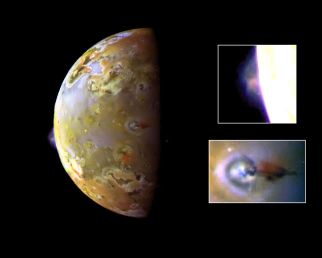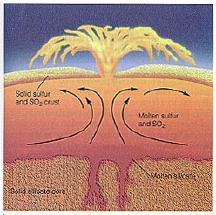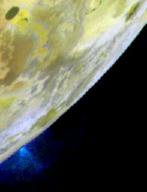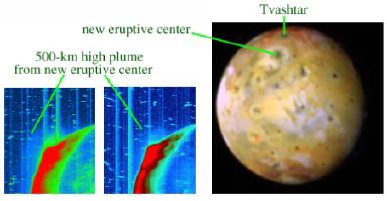Plume Eruptions
Among the most impressive sights in the solar system are the umbrella-shaped plumes that can be seen over many of Io's volcanic centers. Due to Io's low gravity and low atmospheric pressure, dust and gas ejected from volcanic vents rise to great heights before falling back to the surface. Plumes on Io range in height from about 60 km (38 miles) to more than 400 km (250 miles). If Old Faithful in Yellowstone National Park were to erupt on Io, it would rise to an incredible height of 35 km (22 miles).
 When
the plumes were first discovered, planetary scientists
thought that they were explosive volcanic eruptions similar
to those of Mt. St. Helens which erupted in Washington State
in 1980. They have now determined that plume eruptions are
more closely related to geysers on Earth. Geysers are
powered by the change of superheated water to steam as it
nears Earth's surface. Since there is no water on Io, sulfur
and sulfur dioxide are thought to be the fluids that power
the plume eruptions.
When
the plumes were first discovered, planetary scientists
thought that they were explosive volcanic eruptions similar
to those of Mt. St. Helens which erupted in Washington State
in 1980. They have now determined that plume eruptions are
more closely related to geysers on Earth. Geysers are
powered by the change of superheated water to steam as it
nears Earth's surface. Since there is no water on Io, sulfur
and sulfur dioxide are thought to be the fluids that power
the plume eruptions.
 Scientists
have developed models of how plume eruptions may form. One
theory suggests that liquid sulfur dioxide comes in contact
with heated rock or magma at some depth beneath the surface
of Io. This contact causes the sulfurous material to become
superheated and to rise rapidly. By the time it emerges into
the cold atmosphere, it has expanded, cooled, and the
material become a high velocity column of cold gas and frost
particles. When the plume material returns to the ground, it
produces a fallout deposit usually in the form of a circular
or oval-shaped ring. Since plume-like deposits are seen in
many places on Io where plumes are not currently active,
many plume eruptions are thought to be
short-lived.
Scientists
have developed models of how plume eruptions may form. One
theory suggests that liquid sulfur dioxide comes in contact
with heated rock or magma at some depth beneath the surface
of Io. This contact causes the sulfurous material to become
superheated and to rise rapidly. By the time it emerges into
the cold atmosphere, it has expanded, cooled, and the
material become a high velocity column of cold gas and frost
particles. When the plume material returns to the ground, it
produces a fallout deposit usually in the form of a circular
or oval-shaped ring. Since plume-like deposits are seen in
many places on Io where plumes are not currently active,
many plume eruptions are thought to be
short-lived.
Plume eruptions can also form when hot lava flows over an area covered by sulfur dioxide snow. The frozen material vaporizes underneath the lava and erupts through an channel in the flow. This type of plume has been observed at the Prometheus volcano.
 To
keep the plumes erupting, a large and steady supply of
sulfur dioxide is necessary. This may occur as a result of
the recycling of surface deposits of sulfur dioxide.
Scientists speculate that thick sulfur dioxide deposits may
be overrun by lava flows, and those deposits that are not
sublimated (converted instantaneously from solid to gas) are
buried beneath the flow. The lava forms a cap over the
sulfur dioxide deposits, and subsequent lava flows bury the
deposits even deeper. After many repeated flows, the sulfur
dioxide reaches a depth at which it becomes liquefied due to
the high pressure of overlying material. When an underground
intrusion of magma comes in contact with the deeply buried
sulfur dioxide deposit, some of it becomes superheated and
converts to vapor. The pressure from this vapor increases
until a path to the surface is opened, resulting in a plume
eruption. Material ejected during the eruption returns to
the surface and the recycling process is
repeated.
To
keep the plumes erupting, a large and steady supply of
sulfur dioxide is necessary. This may occur as a result of
the recycling of surface deposits of sulfur dioxide.
Scientists speculate that thick sulfur dioxide deposits may
be overrun by lava flows, and those deposits that are not
sublimated (converted instantaneously from solid to gas) are
buried beneath the flow. The lava forms a cap over the
sulfur dioxide deposits, and subsequent lava flows bury the
deposits even deeper. After many repeated flows, the sulfur
dioxide reaches a depth at which it becomes liquefied due to
the high pressure of overlying material. When an underground
intrusion of magma comes in contact with the deeply buried
sulfur dioxide deposit, some of it becomes superheated and
converts to vapor. The pressure from this vapor increases
until a path to the surface is opened, resulting in a plume
eruption. Material ejected during the eruption returns to
the surface and the recycling process is
repeated.

An enormous plume eruption was detected during the August, 2001 flyby from a previously undiscovered volcano. This new plume rose at least 500 kilometers (300 miles) from the ground, 10% higher than the previously recorded tallest eruption. Particles from the eruption detected by Galileo's plasma science instrument were found to be snowflakes composed of sulfur dioxide molecules. These particle impacts will provide researchers with information regarding the temperature and speed of the gas in the plume.
Photo Credits: NASA/JPL
Illustration Credit: NASA
